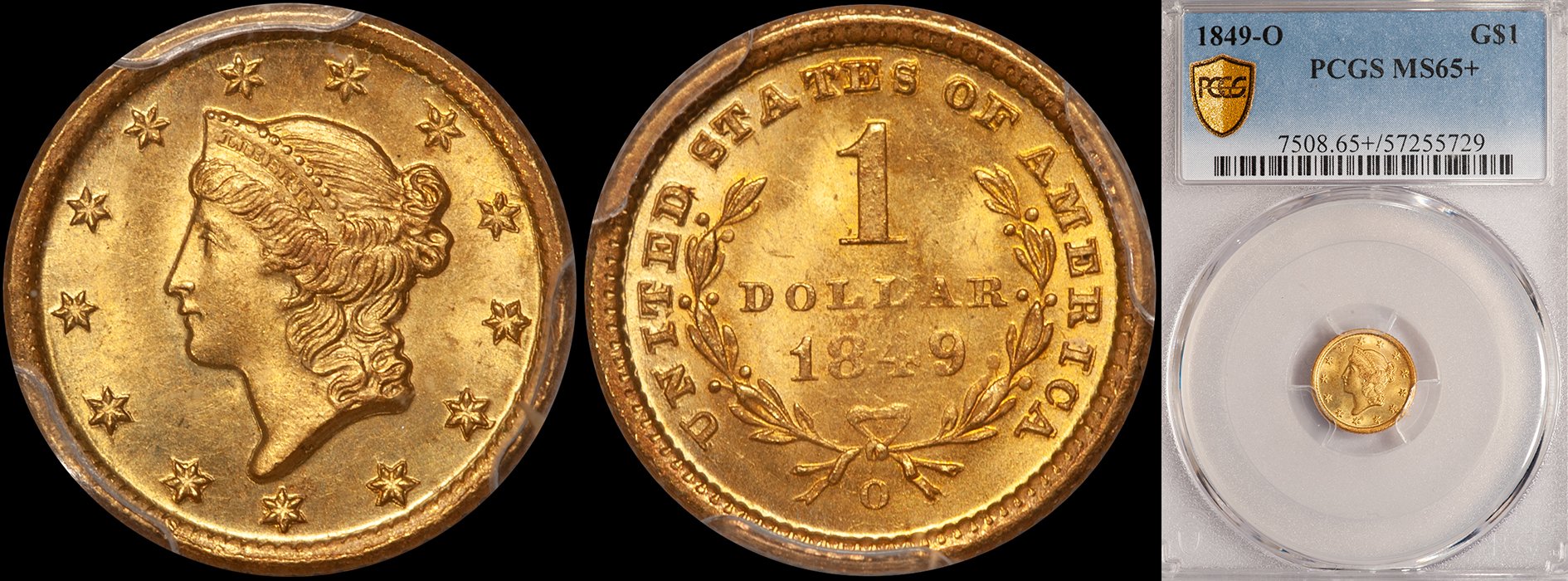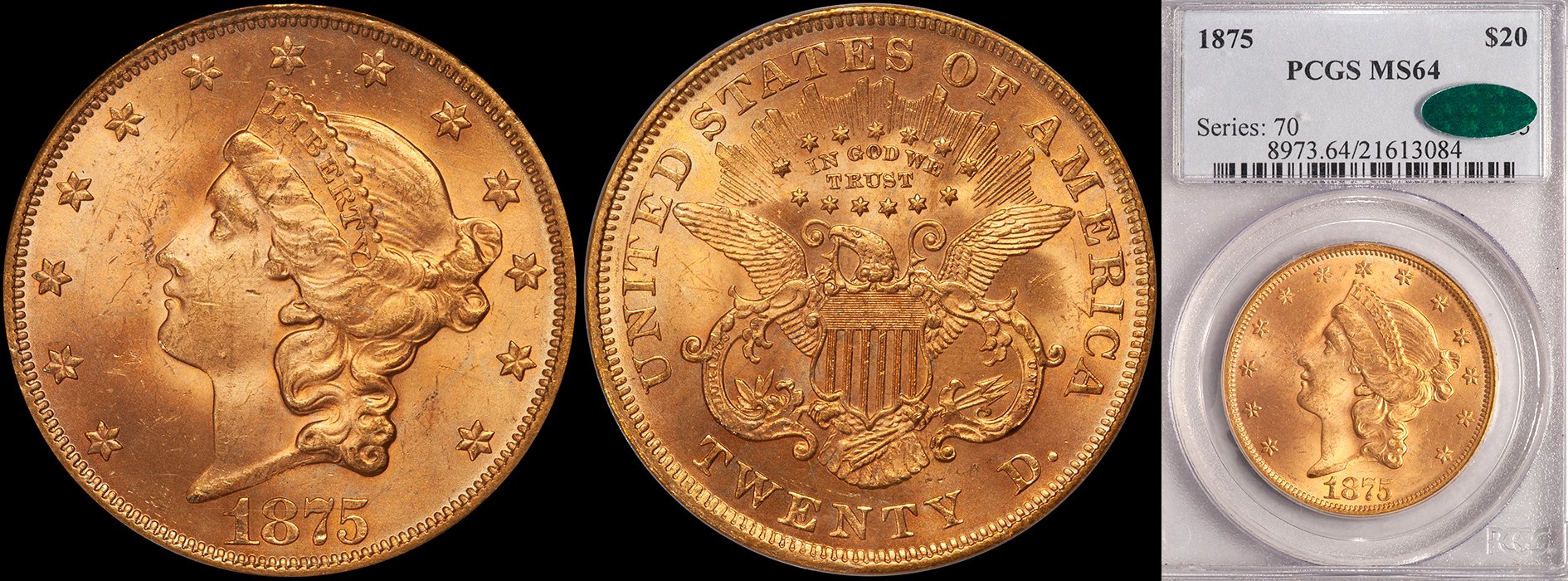The Million Dollar 1870-CC $10.00
/With all of the seemingly endless array of important coins which have traded in the last 30 days (more specifically from just before the ANA show in August up though the end of the month), I think one remarkable sale sort of got lost in the shuffle. In their Rarities Night session held on August 16th, Stack’s Bowers sold the finest known 1870-CC $10, graded AU58 by PCGS and approved by CAC. It sold for $1,080,000 including the buyer’s premium of 20%.
1870-CC $10.00 PCGS AU58 CAC, courtesy of Stack's Bowers
As you probably could have guessed, this smashed the record for any ten dollar gold piece produced at the fabled Carson City mint during their operation period which lasted from 1870 through 1893. To the best of my knowledge, the previous auction price record (APR) for any Carson City eagle was achieved in Heritage’s 2020 FUN sale, where a unique and finest known 1872-CC eagle graded MS62 by NGC brought $240,000. (I am aware of at least two price records over this amount for 1870-CC eagles via private treaty sales).
This was also notable as the second highest price ever paid for a Carson City gold coin of any date or denomination. The all-time price was set by Heritage 11/2021: 3699, an 1870-CC double eagle graded AU53 by NGC, which brought $1,620,000 (my thoughts on that auction are here).
I had heard about this coin when a photo of it was texted to me while it was unencapsulated. The story I was told—and it was repeated in the Stack’s Bowers catalog—was that it had been in the possession of a family from Canfield in Ontario (Canada). I half-heartedly asked the dealer who sent the text if it was for sale. Even from a cellphone image, I could tell the coin was significantly better than any other 1870- CC currently known. The family wisely put the coin in an auction.
“Wisely,” as this was a coin which I completely undervalued and one which I would never have guessed that its final price would break the million dollar mark. In fact, I told two clients that I figured it would bring $400,000-500,000.
So why did this coin bring so much money?
I think the answer is incredibly easy.
If an NGC AU53 1870-CC double eagle sold for $1,620,000 and it wasn’t approved by CAC, certainly the absolute finest known 1870-CC eagle (a coin which is probably 20% less rare overall than its double eagle counterpart) and which is graded by PCGS (that’s good) and approved by CAC (that’s really good) is a no-brainer at half the price of the double eagle, which quickly gets us to $810,000. And if you are a rich guy searching for a trophy coin, what’s an extra $200,000?
And there’s a second scenario—one which I am 100% certain was told to the buyer by his adviser—that is applicable as well.
In October 2022, Heritage sold a PCGS AU53 1875 eagle for $1,020,000. I really need to stress how remarkable this price was because although the business 1875 eagle is a mega-rarity with around nine or so known from an original mintage of just 100, this coin had at least four strikes working against it.
It wasn’t the highest graded.
It wasn’t especially attractive.
There was a previous APR of 372k for a comparable 1875 eagle just four years before, and a more recent APR of 360k (for the exact same coin!).
It was very esoteric.
That said, I can easily imagine any potential buyer of the 1870-CC constructing a scenario in which he basically asks “if an AU53 1875 eagle is worth a million bucks, isn’t the finest known 1870-CC worth a million also?”
And then he may have thought of four things which validated his decision to potentially spend a million on the upcoming 1870-CC eagle.
It was the highest graded.
It was quite attractive.
There were previous APRs, so in theory whatever the coin sold for would represent its current market value.
It was from a popular mint and in a popular series.
When you look at coins from this new perspective (more on this in a moment…) you can see where these “outlier” prices come from. In addition, although I only followed the sale from my screen at home, I sensed there were at least three or four bidders still in at $500K and that the winning bidder was still very much in the game at $900k and would have likely gone higher had it come to that.
It wasn’t that long ago that a million dollar coin was both very unusual and very predictable.
Superb Gem 1795 eagles? Ultra-High Relief $20s? Those were million dollar coins. AU53 1875 or AU58 1870-CC eagles? I never would have imagined these levels in my lifetime.
This is the result of what I call the Doug Winter Theory of Unsophisticated Sophistication.
The DWTUS states that while information about the rarity and availability of rare coins has never been greater or more easily accessible, the ability of a new collector or investor to properly process this information has never been more difficult. The addition of new grades into the Uncirculated range as well as the creation of a new grading service has made numismatic decision-making challenging for experts; let alone for newbies.
Taking the DWTUS one step further, new money sees coins like the 1870-CC eagle and ascribes a previously unheard-of valuation based solely on outlier prices. A sophisticated collector who closely followed the CC eagle market would never have been able to come up with a $1,080,000 valuation for this 1870-CC because there was no context for it to occur. The unsophisticated investor who made the argument I proposed above (comparing this coin to the NGC AU53 1870-CC double eagle) chose a coin which sold for way too much—in my opinion—and formed a conclusion based on an unsound premise; i.e., that the 70-CC $20 in NGC AU53 would sell for the same amount if re-offered today. This is where the un-sophistication comes into play and where it misinterprets the data.
Another esoteric coin which sold for an inexplicably high price is the Simpson PCGS/CAC MS63+ 1795 Nine Leaves $10 which brought a jaw-dropping $3,360,000 when it was auctioned in January 2022. This price was way beyond what I expected it to bring because of the fact that the 1795 Nine Leaves is a variety (and an esoteric variety at that) and that no less than five other examples have been graded MS60 or finer by PCGS. The very same coin sold in 2015 for $1,057,000 and I expected it to bring around $1,650,000 to $1,850,000. When a higher graded PCGS MS64 from the Bass Collection came up for sale in early 2023, it brought “just” $2,100,000. Although the Simpson coin was clearly finer than the Bass coin (which I graded MS62), it couldn’t have thrilled the owner that another high grade 1795 Nine Leaves eagle brought more than a million dollars less.
I am in no way attempting to denigrate the importance of any of these coins. I personally love the Simpson 1795 9 Leaves $10 and the Canfield 1870-CC eagle; just not at the levels which they sold for.
The sale of the million dollar 1870-CC eagle shows how the concept of what is a Trophy Coin in 2023 is and how it differs from what a Trophy Coin was as recently as 2020. I don’t feel that this change is complete, and we are likely to see more totally unpredictable auction price records for US gold coins in the coming years.


















